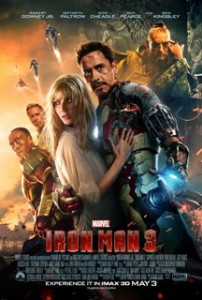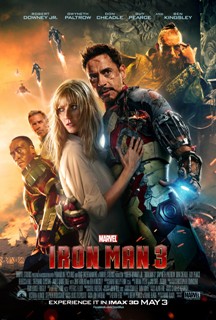Iron Men and Women: Why Fragility Isn’t a Bad Thing
It’s that time of year – summer movie season. Shifting The Great Gatsby from Christmas to May certainly didn’t hurt its opening weekend box office, earning roughly $10 million more than analysts had predicted. But it didn’t come close to toppling Iron Man 3 in its second weekend. On Wednesday at the Cannes Film Festival, Leonardo DiCaprio pointed out that Gatsby is about a man “trying to become a great Rockefeller, a great American, and somewhere along the way has lost a sense of who he was.” While Tony Stark is probably already richer than the Rockefellers, he is trying to live up to the name Stark, which is equally as burdened with an American legacy in the Marvel-verse.
 At her blog Under the Mask, clinical psychologist Andrea Letamendi takes a deep dive into the psyche of Tony Stark, using his story to shed light on Post-Traumatic Stress Disorder. Generally, superheroes are shown surpassing insurmountable odds and digging deeper internally to overcome circumstances that would thwart the average person. Nevertheless, the best superhero stories allow the audience to connect with the character emotionally; their stories are relatable despite the audience’s inability to fly or smash things with a fist or hammer. It’s generally not even the villain who poses the greatest obstacle to heroes, but their relationship with self or family and loved ones. The dramatic manifestation of superpowers to defeat the Big Bad serves to enhance the emotional experience of conquering the foe. For stories to be successful there has to be two victories – one thematic and one objective. It’s important for storytellers to understand that it’s not the superpowers and the objective victory that make superhero tales successful, but rather the humanity of the characters and their struggles within.
At her blog Under the Mask, clinical psychologist Andrea Letamendi takes a deep dive into the psyche of Tony Stark, using his story to shed light on Post-Traumatic Stress Disorder. Generally, superheroes are shown surpassing insurmountable odds and digging deeper internally to overcome circumstances that would thwart the average person. Nevertheless, the best superhero stories allow the audience to connect with the character emotionally; their stories are relatable despite the audience’s inability to fly or smash things with a fist or hammer. It’s generally not even the villain who poses the greatest obstacle to heroes, but their relationship with self or family and loved ones. The dramatic manifestation of superpowers to defeat the Big Bad serves to enhance the emotional experience of conquering the foe. For stories to be successful there has to be two victories – one thematic and one objective. It’s important for storytellers to understand that it’s not the superpowers and the objective victory that make superhero tales successful, but rather the humanity of the characters and their struggles within.
When the flagship line of Star Wars Expanded Universe novels progressed down the timeline, its Jedi heroes leveled up in their abilities much like a player would in a video game. To match them in combat, their foes increasingly required powers beyond imagination. For all the superpowers and the spectacular and gruesome battles that dynamic yielded, the emotional trials for the novels’ protagonists never progressed with any sense of realism or relatability. On the other hand, for instance, consider Star Trek Into Darkness, where the Enterprise crew engages the villain – there are flashes of brutal violence, but they do not dominate the movie, instead punctuating the grave danger for our heroes. When movies or books become steeped in violence they run the risk of the audience detaching from the story, and it appears Abrams and his team are very aware of that dynamic and how to balance the tension between the external and internal battles.
In the highly successful Hunger Games series, Katniss Everdeen experiences tremendous growth as a warrior and a leader. In the Iron Man movies, Tony Stark evolves from a brilliant rebel to an American hero through a harrowing and unrelenting series of events. In both cases, the psychological ramifications of all that had happened to the heroes continually added weight and burden to their emotional journey. They don’t magically reset their personalities or mental health for each new story – and rightfully so, because that’s not how human beings process emotions. This emotional layering appears for Spock in the new Star Trek movie, as well. In this way, incredibly strong characters remain flawed and the story remains dramatic.
As Tony Stark and Katniss Everdeen become better warriors, so too do they risk becoming more fragile humans. Katniss is shown as a girl who trembles in fear in the first book to one sidelined and catatonic by her emotional demons in another. The question posed by the story is: Can she find a way to not become a victim of the emotional trauma she has suffered? It’s the fact that, in the end, she doesn’t let those emotions define her that makes her actions and choices compelling. Letamendi’s piece details the anxiety and panic attacks that plague Iron Man 3’s hero:
Tony’s struggle with anxiety is poignant because it allows us to realize that he is, in fact, still human. To this end, it doesn’t matter to me if his panic attacks are indicative of clinical PTSD, complex PTSD, subclinical anxiety disorder or another psychiatric category we can use as a label. The point is this: A brilliant, powerful, and tough guy can be vulnerable, scared, and confused. Tony Stark is a superhero with the psychological makeup of a human. He is “just a man in a can,” after all.
Powering ahead into the new adventures of Star Wars on the silver screen, with the stunning visuals available through special effects and computer generated imagery, hopefully the human element of the franchise’s success will not be lost on the storytellers. After all, for most of the Original Trilogy not even Luke Skywalker had bombad Jedi powers, yet his journey is to this day one of the most beloved – and it ends with him laying down his weapon.
While Iron Man 3 is known for its brash hero, director Shane Black and co-writer Drew Pearce intended all along to defy the stereotypical roles for women in superhero movies in the third installment. At Wired.com Laura Hudson discusses “How Iron Man 3 Flips the Script on Female Characters.”
If that seems like a bold statement about a secondary character in a film, consider that the genius in Iron Man 3 who creates a powerful – indeed, perhaps too powerful – form of technology capable of changing the world isn’t Tony Stark; it’s Maya. And the hero who ultimately saves the day by taking out the bad guy in smash-em-up physical confrontation isn’t Tony Stark; it’s Pepper Potts. Sure, Tony Stark and the Mandarin are ostensibly the hero and the villain, but if you look at the things that people actually do rather than where the camera happens to focus, the female characters are the ones who truly begin to shine.
One of the most important things about Iron Man 3 – particularly as a film in the superhero genre, whose iconic heroes tend to be white guys created by white guys circa Mad Men or earlier – is the way that it allows its female characters to evolve from minor to meaningful. Initially introduced as one of Tony’s sexual conquests from his pre-Pepper days, Maya could have easily been relegated to little more than a Bond Girl. Instead, her intellect and ability create the impetus for the entire film: a weapon that might have been powerful enough to destroy Tony Stark – if he hadn’t been saved, in the end, by a woman. Similarly, Pepper Potts starts out as Tony’s assistant, and becomes up not only as the CEO of Stark Industries, but transforms into a superhero herself.
Despite great female characters on the rise in cinema, books, and television, the discussion about the need for stories to portray strong female characters is unfortunately still far from past its time. This week’s piece “Where Have All the Women Gone?’ from the L.A. Times, for example, notes a drop in the number of speaking roles for women and increases in the portrayal of women in sexually revealing clothing, including a 20% increase since 2009 for teen girls being shown dressed provocatively. These numbers are based on a just-released study by the Annenberg School for Communication & Journalism at the University of Southern California, in which the 100 top-grossing fictional films from 2012 were studied. In a Huffington Post article on the study, the study’s lead author Stacy Smith is quoted from her press release:
The last few years have seen a wealth of great advocacy for more women on screen. Unfortunately, that investment has not yet paid off with an increase in female characters or a decrease in their hypersexualization.
Whether we label them strong female characters, impactful female characters, featured female protagonists, or simply well-written female characters, the heart of the problem is that if the numbers of female characters represented on screen is still declining, then we’re experiencing fewer of all types of female characters. By definition Iron Man is a superhero, and that definition implies he has strength and that the character is male. In no way does Tony Stark being strong male character suggest he isn’t weak in other ways. In fact, the success of Iron Man 3 suggests that an emotionally flawed superhero is quite compelling, especially when there are powerful and capable women rounding out his story. Strong female characters deserve comparable treatment, like Katniss received, in both their physical and emotional strengths as well as their flaws and vulnerabilities.
I’ve discussed numerous times the importance of women becoming part of the storytelling process, whether as writers, directors, or producers. The Annenberg School report seems to validate this as an effective way to change the state of female characters in movies:
When a female works behind the camera in the key creative role of writer or director, there are more women shown on screen, and fewer female characters are hypersexualized.
We’re still climbing uphill. Not that I don’t look forward to the discussion of ‘we need more strong female characters’ being a thing of the past, but we’re not even close to equality of portrayals yet.
- Ten Years of Hyperspace Theories - October 28, 2024
- Hyperspace Theories: The Heroine’s Journeys of the MCU’s Echo and What If? Series - August 29, 2024
- Hyperspace Theories: THE ACOLYTE and Star Wars Brand Management - August 7, 2024










Yeah, some progress has been made but we’ve got a long way to go yet.